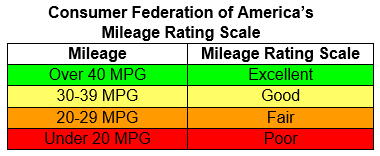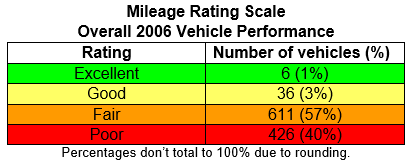Washington, DC – A Consumer Federation of America (CFA) analysis of EPA mileage ratings for 2006 vehicles released today reveals huge differences in fuel efficiency within vehicle classes.
“Fuel efficiency varies by at least 100 percent in most car classes,” said Jack Gillis, CFA’s Director of Public Affairs and author of The Car Book. “These differences mean that a car buyer’s best defense against rising gas prices is to shop carefully within the class of car they are considering. Consumers can save hundreds of dollars a year by simply buying a higher rated subcompact, SUV or minivan. And our nation can dramatically reduce our dependency on foreign oil at the same time,” he added.
Among the findings:
- There is a huge range in fuel economy performance within vehicle size classes.
- Among the relatively few hybrid vehicles, fuel efficiency varies widely: the Chevy Silverado (pickup) gets only 18 mpg (Poor) while the Honda Insight (two seater) gets 56 mpg (Excellent). o Consumers can save nearly $2000 in fuel costs by choosing the most fuel efficient vehicle in their preferred size class.
“Personal fuel efficiency increases of 5 to 10 miles per gallon are possible with off-the-shelf technology and without changing classes of cars. If consumers bought the most efficient auto within the class, as opposed to the least efficient, they would consume much less gasoline,” said Dr. Mark Cooper, CFA’s Director of Research.
“American consumers care about our nation’s oil ‘addiction,’ which has been fostered by a fleet average fuel economy that has been stuck at 20 mpg since 1991. Recent CFA research reveals that our dependence on foreign oil and its effects on the price of gas are among their top concerns,” said Cooper. “What Americans need is a way to make more informed choices about their oil consumption.”
New Mileage Rating Scale
In order to heighten consumer awareness of vehicle fuel efficiency and to motivate changes in both purchase behavior and manufacturer production, CFA has developed a new Mileage Rating Scale (MRS).

“By helping consumers to quickly identify which new or used vehicles are Excellent, Good, Fair or Poor, in terms of gas mileage, the Mileage Rating Scale enables them to make more informed vehicle purchases,” said Gillis. “Just as we saw with safety ratings, when consumers are able to easily compare performance, they quickly vote with their dollars. And smart manufacturers respond by providing the choices consumers want. They have the technology to make even their largest cars get 30 miles per gallon at a minimum,” said Gillis.
Today, relatively few vehicles meet the Mileage Rating of “Excellent.” As the table below shows, of all the 2006 cars rated by the U.S. EPA, only 1% achieve an “Excellent” rating while 40% receive a “Poor” rating.
The MRS provides a simple measure of manufacturers’ response to the need for more fuel efficient vehicles, which CFA will use to track overall industry performance on an annual basis.

Motor Vehicle Fuel Efficiency Varies Widely
In comparing new vehicles, CFA analysis used EPA’s combined fuel economy average of both city (55%) and highway (45%) driving of the more popular cars and trucks on the market, including the most often purchased vehicles and excluding the rarely purchased high priced luxury vehicles. Because this analysis is based on vehicle popularity, it does not include manual transmission vehicles, some of which have higher MPGs or ethanol vehicles because of the limited availability of ethanol. (A note about ethanol: While ethanol fuel may not currently be as readily available as straight gasoline, it dramatically reduces the need for gasoline.)
The most striking finding of CFA’s analysis of EPA data is that there is significant variation in fuel efficiency within vehicle classes. In addition, this table reveals the enormous difference in fuel costs within size class.

Mileage Rating Scale: Potential Change Maker
As a simple, straightforward method of rating cars for fuel efficiency the MRS has the potential to change consumer behavior. CFA plans to publicize the scale widely and get the MRS included on window stickers, advertisements, in overall vehicle rating systems and automobile buying guides. The presence of the MRS in the market will empower consumers and thereby create competition among the manufacturers to improve their fuel economy performance. In the future, the EPA will be adjusting the method it uses to calculate fuel economy ratings. The new method will more closely match real world performance and will result in 5 to 30 percent drops in fuel economy ratings. At that time we will adjust the rating scale.
While our focus is on exposing the dramatic differences in fuel efficiency within size classes, our analysis also showed a wide range among the most popular vehicles. Of the vehicles with over 150,000 sales per year the range between the best and worst is dramatic. The most fuel efficient includes the Honda Insight 56 mpg (Excellent), Toyota Prius, 55 mpg (Excellent), and VW Golf and Beetle, 40 mpg (Excellent). The least fuel efficient include versions of the Dodge Ram 1500 10 mpg (Poor), Jeep Grand Cherokee 13 mpg (Poor), and Mercedes Benz G Class 13 mpg (Poor).
Increased Vehicle Fuel Efficiency by Informed Vehicle Choice is Critical to Reducing Gasoline Consumption and Oil Imports
An increase of 5 miles per gallon in the fuel efficiency of our domestic fleet would save approximately 23 billion gallons of gasoline each year, reducing imports of oil and oil products by an estimated 14 percent. A fleet-wide increase of 10 miles per gallon would save 38 billion gallons, cutting imports by almost one-fifth. Combined with CFA’s recommended twelve simple fuel savings tips, Americans could achieve a total annual savings of 50 billion gallons, or one-quarter of total crude oil and gasoline imports. If similar savings were achieved for diesel fuel, imports could be reduced by another 5 to 10 percent.

